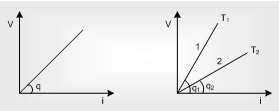If the physical conditions of the conductor (length, temperature, mechanical strain etc.) remains some, then the current flowing through the conductor is directly proportional to the potential difference across its two ends i.e. i ∝ V => V=iR ; where R is a proportionality constant, called as electric resistance.
1. Ohm's law is not universal laws, the substances, which obey ohm's law, are known as ohmic substance.
|
2. Graph between V and i for a metallic conductor is a straight line as given. At different temperatures V-i graphs are different.
|

|
3. The device or substances which don't obey ohm's law e.g. gases, crystal rectifiers, thermo-ionic valve, transistors etc. are known as non-ohmic or non-linear conductors. For these V-i curve is not linear.
|
Static resistance 
Dynamic resistance 
|

|
Email based Physics assignment help - homework help at Expertsmind
Are you searching physics expert for help with Ohm's Law questions? Ohm's Law topic is not easier to learn without external help? We at www.expertsmind.com offer finest service of Physics assignment help and physics homework help. Live tutors are available for 24x7 hours helping students in their Ohm's Law related problems. We provide step by step Ohm's Law question's answers with 100% plagiarism free content. We prepare quality content and notes for Ohm's Law topic under physics theory and study material. These are avail for subscribed users and they can get advantages anytime.
Why Expertsmind for assignment help
- Higher degree holder and experienced experts network
- Punctuality and responsibility of work
- Quality solution with 100% plagiarism free answers
- Time on Delivery
- Privacy of information and details
- Excellence in solving physics queries in excels and word format.
- Best tutoring assistance 24x7 hours